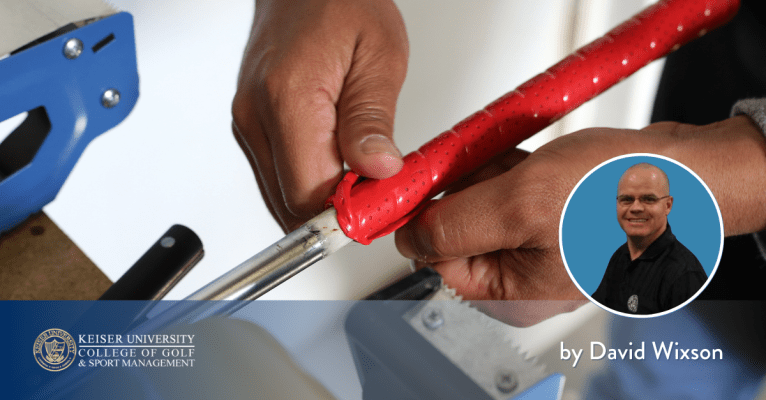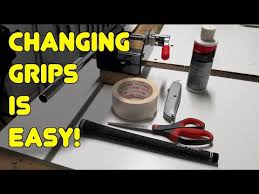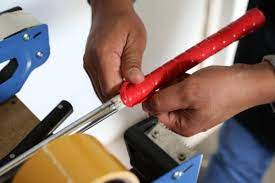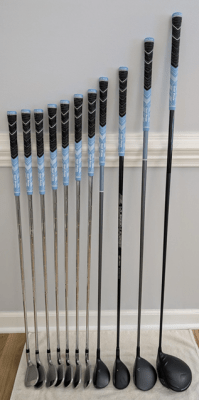How to Regrip a Golf Club: A Step-By-Step Guide

By David Wixson, Keiser University College of Golf Professor – PGA Master Professional
Regripping your golf clubs is a straightforward process that can improve your game by ensuring better control and comfort. This guide provides detailed step-by-step instructions for regripping a golf club at home, along with a few pictures to enhance understanding. You’ll need basic tools and materials, and with a little practice, you can achieve professional-quality results.

Materials Needed
- New golf grip
- Double-sided grip tape
- Grip solvent (or mineral spirits)
- Utility knife or hook blade
- Vice and shaft clamp (optional but recommended)
- Clean cloth or rag
- Bucket or tray (to catch excess solvent)
- Measuring tape or ruler
- Scissors
- Spray bottle (optional, for solvent application)
Step-by-Step Instructions
Step 1: Secure the Club
- Secure the golf club in a vice with a shaft clamp to hold it steady, ensuring the clubhead is pointing upward.
- If you don’t have a vice, you can hold the club firmly or have someone assist you. This prevents the shaft from moving during the process.

Step 2: Remove the Old Grip
- Using a utility knife or hook blade, carefully cut through the old grip lengthwise along the shaft.
- Start at the top (near the grip’s cap) and slice downward, taking care not to damage the shaft, especially if it’s graphite, as it’s more delicate than steel.
- Peel off the old grip and remove any remaining tape residue using a cloth and solvent.

Step 3: Clean the Shaft
- Wipe down the exposed shaft with a clean cloth and grip solvent or mineral spirits to remove any leftover adhesive or debris.
- Ensure the shaft is completely clean and dry before proceeding to ensure a strong bond with the new tape.
Step 4: Apply Double-Sided Grip Tape
- Measure and cut a strip of double-sided grip tape to match the length of the new grip (typically 10-11 inches).
- Peel off one side of the tape’s backing and wrap it around the shaft, starting just below where the grip will end. Let 1/2″ of grip tape overhang the butt end of the shaft.
- Wrap tape around the shaft; smooth out any wrinkles.
- Twist the 1/2″ overhang of tape into the shaft opening.

Step 5: Prepare the New Grip
- Place a bucket or tray under the work area to catch any excess solvent.
- Cover the hole at the bottom of the new grip with your finger or tape, then pour a generous amount of grip solvent into the grip.
- Close the top opening with your other hand and shake the grip to coat the interior evenly.
- Remove your finger or tape and pour the excess solvent over the taped shaft to wet the tape.

Step 6: Install the New Grip
- Quickly slide the new grip onto the shaft while the tape and grip are still wet with solvent.
- Start at the butt end and push the grip on, aligning it with the clubface (use alignment marks on the grip if available).
- Work fast, as the solvent dries quickly. Ensure the grip is fully seated, with no tape exposed at the bottom of the grip.

Step 7: Adjust and Clean
- Once the grip is on, double-check its alignment with the clubface.
- If adjustments are needed, gently twist the grip while the solvent is still wet.
- Wipe off any excess solvent or adhesive from the grip and shaft with a clean cloth.
- Remove the club from the vice if used.
Step 8: Let the Grip Set
- Place the club in a safe, upright position and allow the grip to dry for at least 12-24 hours to ensure the adhesive bonds properly.
- Avoid using the club until the grip is fully set to prevent slipping.

Tips for Success
- Work in a well-ventilated area: Grip solvent can have strong fumes.
- Use enough solvent: This makes sliding the grip on easier and prevents sticking.
- Check alignment carefully: A misaligned grip can affect your swing.
- Practice on an old club: If you’re new to regripping, practice on a spare club to build confidence.
Conclusion
Regripping a golf club is a cost-effective way to maintain your equipment and enhance your performance on the course. By following these steps and using the right tools, you can achieve a professional-quality grip installation at home. Regular regripping (every 40-60 rounds or annually) keeps your clubs in top condition, ensuring a confident and comfortable swing.















have golf works regrip tape. doesnt seem to have two sided adhesive for regripping. what am i missing?